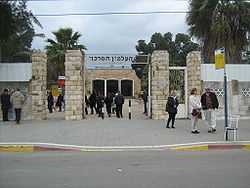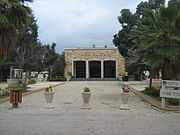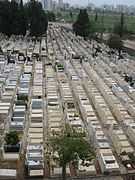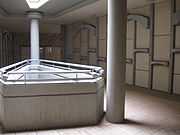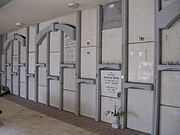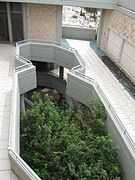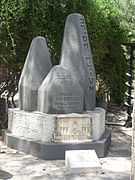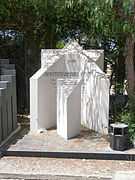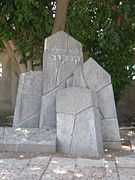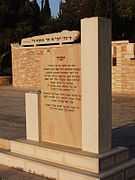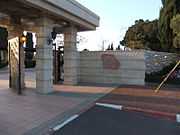Kiryat Shaul Cemetery (Hebrew: בית העלמין קריית שאול) is a 320-dunam (79.07 acres) Jewish burial ground in Northern Tel Aviv near the neighborhood of Kiryat Shaul. On the east side of the cemetery is a large military cemetery. Founded in 1943,[1] it includes more than 80,000 graves, including those of Israeli political and cultural figures. Due to lack of space, since 1991, the Yarkon Cemetery has been serving as the main cemetery for the Tel Aviv Metropolitan Area.
History
The Cemetery was established in 1943 when the Chair of the Religious Council of Tel Aviv, David-Zvi Pinkas, feared that they will run out of burial space in the Nahalat Yitzhak Cemetery. Chairman of the Chevra kadisha, Zalman Meisel, opened in negotiations to purchase the land. The purchase was completed in 1949. During its early years, the cemetery faced strong opposition, particularly from Planning Division at the Ministry of Interior. The opposition slowly subsided the following year.
While the sign above the entrance still say "Central Cemetery", due to dwindling burial places, Yarkon Cemetery which opened in 1991 near Petah Tikva now serves as the main cemetery for the Tel Aviv Metropolitan Area. While Kiryat Shaul still accepts new burials, it is categorized as a "closed cemetery" by Bituah Leumi, allowing the collection of fees.
Like most other cemeteries in Israel, Kiryat Shaul cemetery erected memorials in memory of the victims of The Holocaust. Under Some of the monuments buried the remains, ashes and bones that were brought back from the extermination camps. The memorials include: Jews of Brest , Bukovina, Minsk, Kraków, Oświęcim, Radom, and Ivano-Frankivsk.
Additionally, there is a dedicated plot for the Righteous Among the Nations and another for victims of terrorist acts. Nearby the entrance to the cemetery 5 of the Munich massacre victims are buried. There is also a grave for the remains of the victims of the El Al Flight 402 plane crash that took place over Bulgaria in 1955.
The Cemetery is the resting place of many of prominent military and cultural figures. Among them - Alexander Penn, Nathan Alterman, Abraham Chalfi, Avraham Shlonsky, Tirza Atar, Dahlia Ravikovitch, Natan Yonatan, Shmulik Chizik, Moshe Shamir, Moshe Vilenski, Mordechai Zeira, Nahum Nardi, Daniel Samborski, Izhak Graziani, Hanna Rovina, Shmuel Rodensky, Yafa Yarkoni, and many more.
Burial tower
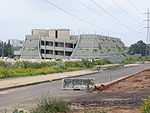
Burial tower
In 1999 additional burial plots were added at the north-west side of the cemetery. On that site a three-story, step-pyramid shaped building was built. Connecting the floors is a staircase and a ramp. The structure is divided into shaded burial halls and shafts where vegetation grows under direct sunlight. The overall design is based on the Tombs of the Sanhedrin. Family estates can be purchased at the tower.
Military Cemetery

Entrance to the Military Cemetery
On the eastern side of the cemetery is a large Military Cemetery.
References
Gallery
| Kiryat Shaul Cemetery |
|---|
| El Al Flight 402 memorial |
| Entrance to the Military Cemetery |
|
